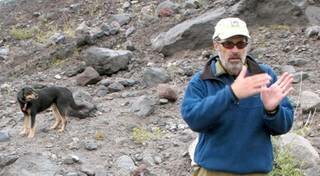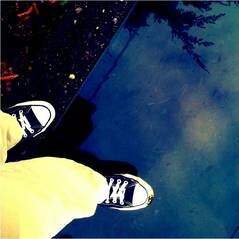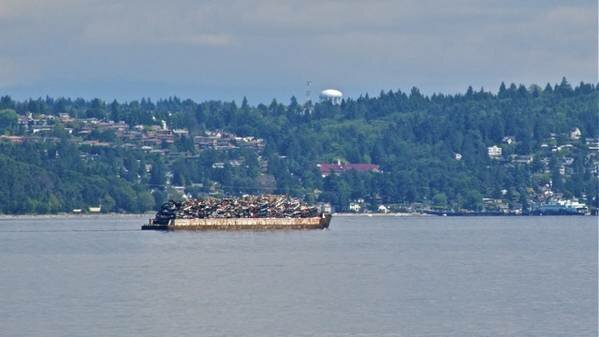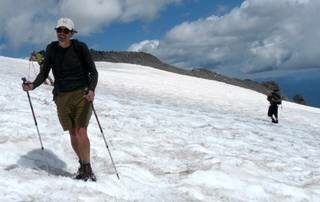The New York Times seems delighted to dispel any remaining myths about the untouched natural beauty of Washington state. Just this week readers have learned that there's three times the amount of plutonium waste at Hanford as "thought," and that the Puget Sound's pH level is declining in part due to ocean acidification and the water is growing more corrosive. (Thanks. We'll be expecting a make-up "36 Hours in Seattle," soon.)
The Seattle Times goes straight to the pH-decline bottom line: the impact on the Puget Sound shellfish industry.
The Taylor Shellfish hatchery on Hood Canal's Dabob Bay had its first good year in several in 2009, but company spokesman Bill Dewey said he suspects that's merely because the winds cooperated, preventing acidified seawater from entering the relatively stable bay.
The company recently installed sophisticated pH monitors at its hatchery to determine when it's best to draw water off the surface, from way down deep—or not at all.
In an earlier story, from January this year, the Seattle Times looked at the cause-and-effects of ocean acidification in general. The world's oceans act as a carbon dioxide sink, claiming excess CO2 from the atmosphere, but CO2 dissolved in water creates a weak acid solution. It turns out that shellfish larvae, for one, are very sensitive to changes in pH.
The new study on the Puget Sound's ocean-acidification intake represents the work of researchers with NOAA, the University of Washington, and the state's Department of Ecology. (It's published in the latest issue of Estuarine, Coastal and Shelf Science.) The researchers make it clear that the Sound is struggling mightily with the human activity around it--the toxic pollution and "nutrient-rich" flows that are channeled into it, both killing off life and promoting algae blooms that...also kill off life....
 Steve Malone, on Mount St. Helens with Scooter the seismo-dog
Steve Malone, on Mount St. Helens with Scooter the seismo-dog
"The longer it's been since the last earthquake," said Steve Malone, brightly, "the sooner it is 'til the next one." We were in his office at the University of Washington--he's retired from full-time seismologizing, but still spends unpaid hours on campus answering questions from pesky bloggers, even if they're fueled by sensationalist speculation about more frequent quakes.
He refocused my question away from end-time paranoia toward common sense acceptance: "We have several of these faults: there's the Seattle Fault, and there's one down in the Tacoma basin, one up at Everett and Whidbey Island…so if you say, we've got eight or ten of these faults, even if the earthquakes go once every thousand years, you sum them up, you could have something every few hundred years of some consequence," explained Malone. "You don't know, it could be 500 years, or it could be tomorrow."
He also assured me that, incredible as it seems, it's perfectly plausible that the recent Baja quake could have generated waves at a Ballard pool. "Large earthquakes generate big surface waves, and big surface waves generate a bit of a tilt as they go through. If a body of water's natural free period happened to be the same as the frequency of those surface waves, then after a couple of cycles you might see it get built up enough," said Malone. "The motions of surface waves can be on the order of centimeters. We just don't feel it because it's very slow."
As an afterthought, he added: "The Denali quake of 2002--bigger than Baja [7.9] but further away--it generated a sloshing in Lake Union that damaged houseboats."
And because I had to ask: "Tunnels aren't usually an issue with earthquakes. The motion underground is less than on the surface, and they're already built to withstand the pressures of everything else."
As it turned out, we ended up talking across the breadth of Malone's career, covering volcanic earthquakes, megathrust quakes, and the mysterious Episodic Tremor and Slip (ETS). His interest in seismology developed in graduate school; he'd studied physics as undergraduate, but was not "keen on modern physics" and gravitated toward geology, then seismology. At first he enjoyed the outdoors aspects of the work, "particularly in the volcano world," but as his research progressed, he ended up in the office running computer models.
"Since I retired I get to go out and play," he said, smiling. "I volunteer for all sorts of fieldwork." He's been up on Mount Rainier working on an upgrade of instruments there, and out on the Olympic Peninsula conducting ETS studies in advance of the next appearance of the phenomenon.
"The ETS we have here are fairly regular, every 14 and a half months or so. The next one is scheduled--if you can call it that--for sometime mid-summer, maybe mid-August. We've got some experiments we're planning to gear up and get extra equipment in the ground for. There's some extra equipment out there now, running in background mode, but when the ETS arrives we'll double the equipment, trying to look ever closer at it."...
 Maybe if stormwater wasn't so pretty and shimmery, we'd be more upset about what run-off does. But who doesn't love an oily puddle rainbow?
Maybe if stormwater wasn't so pretty and shimmery, we'd be more upset about what run-off does. But who doesn't love an oily puddle rainbow?
Even if you recognize there's a threat, you're still just one person. Against rain. In the Pacific Northwest. Good luck with that, Noah.
Sightline's stormwater report acknowledges these truths. They give you the scope--a single Puget Sound home produces over 26 thousand gallons of run-off each year-- subtitle the horror story "Stormwater's costly and toxic cocktail," and talk about "what you can do."
Still, you and I and The Onion know how we think. If we were neo-hippies and lived in Fremont and derived a great deal of our identity from nagging other people about their wastefulness, we might think about painting a rain barrel with a Day-Glo mandala, sure. That soft rainwater is just what Dr. Bronner ordered!
That's why it's cheering to see a Seattle Metropolitan story on rain gardens. What we need to hear is, "It’s a nice oasis." Why? Because this environment thing is a leaky boat. Seattle has a great recycling percentage, we almost banned plastic bags, and not only did we screw in a bunch of CFL light bulbs, but we're going to take the dead ones back to Bartell's, too.
Each of these things requires personal effort--each draws from the limited fund of attention we can give to monitoring our "bad" behavior. And looking around, it's easy to see we'll be running crushing mental deficits far before we get this sustainable thing off the ground. (It's also why guiding principles are better than regulating homeowners into frustrated immobility, but that's another post.)
Doing something that just works better, by contrast, requires none of that sustained, best-behavior hall-monitoring. You go to a home show in Tacoma or Seattle, you get a sense of what a rain garden can do for you, you learn that Seattle will help pay you to install one--suddenly it's not a battle. A backyard "oasis" that keeps your basement from flooding and gives you neighborhood bragging rights? Bring it, Fremont rain-barrellers!...
Seattle PostGlobe tipped us off to this Three Sheets Northwest story on the razor clam season opening tomorrow, October 16. The department of fish and wildlife has given the okay for digging on five Washington coast beaches. You need a license if you're over 15, and you're allowed to dig up 15 clams.
That's in contrast to northern Puget Sound, which the Seattle Times reports has a terrific case of "red tide" toxins. You don't want to chance it: "The department said Thursday that tests found so-called 'red tide' toxin levels up to 100 times the closure level." There's a table of open/closed shellfish beaches here.



Most Recent Comments